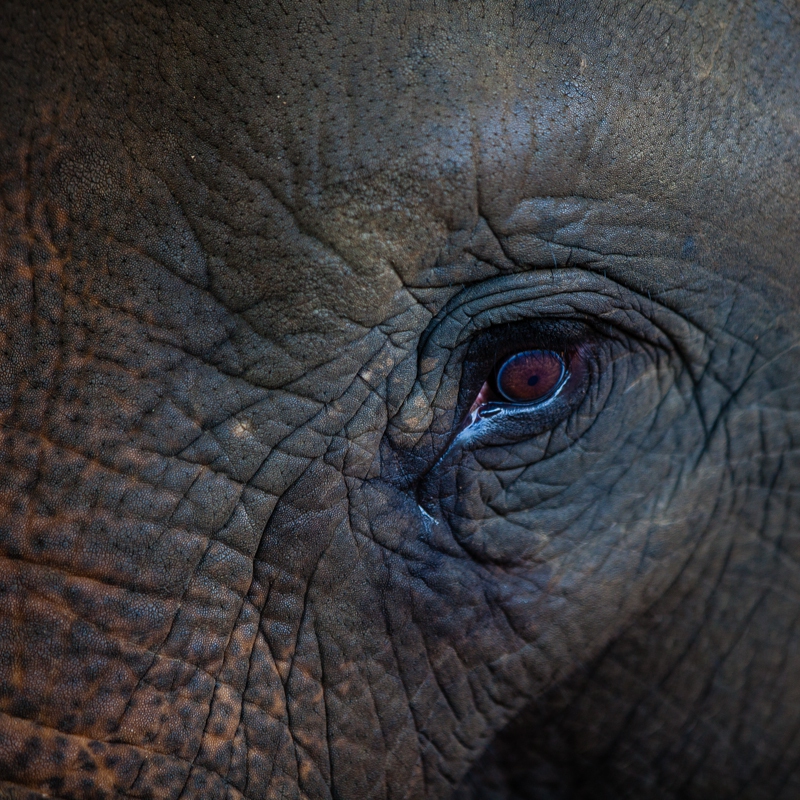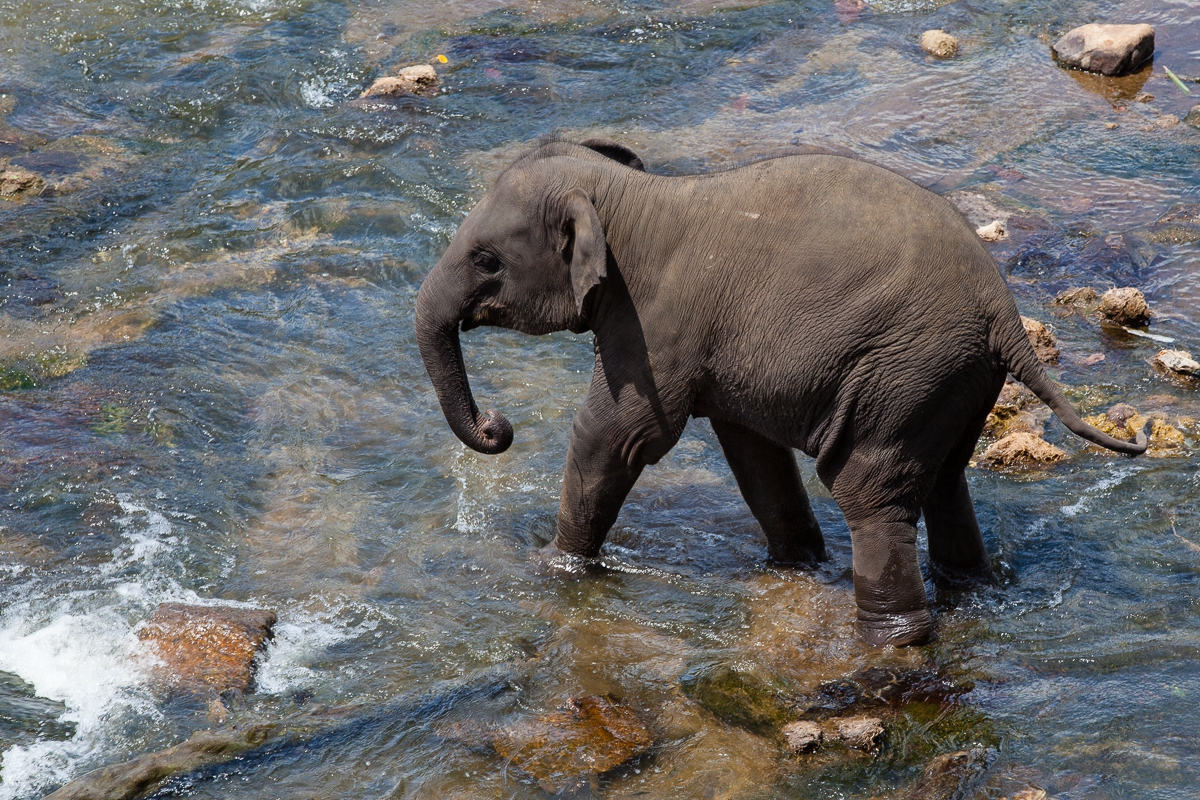Category: Travel
While on safari in Yala Nature Reserve in Sri Lanka, our tracker told the driver to stop and then pointed out some small crocodiles sunbathing in the mud on the other side of a fair sized bit of water. He did very well to spot them without binoculars, but he would have been extremely disappointed if he had known that I was not in the slightest bit interested in taking shots of these little crocodiles, and instead was busy shooting away, capturing this wonderful Painted Stork (Mycteria Leucocephala) that was prancing around on the near side of the water.
This photo of a baby elephant paddling in the river is a taster of our visit to the Pinnawela Elephant Orphanage which was probably the highlight of our two weeks holiday in Sri Lanka. Watching the stampede of a herd of baby elephants running through the village to the Pinnawela River, and seeing the sheer joy of these orphans paddling mischievously in the river was just amazing to watch.
During our safari at Yala Nature Reserve in Sri Lanka, we encountered plety of water buffalos. May not the most exited spieces we encountered, but they made for some spectecular sights. This one enjoying a mud bath is my favourite without a doubt.
The majority of water buffalos we saw were, you guessed it, in the water somehow. Whether lying in a muddy pool, half submerged, or eating greens while wading through shallow waters, the water and the mud seems to form part of their enjoyment in life.
The second highlight of our river safari up the Balapitiya River in South West Sri Lanka was seeing the water monitor. We spotted it swimming towards the middle of the river, but as soon as our boat with the noisy outboard got anywhere near it, it headed back to the mangroves.
I felt sorry for the monitor, as our guide was literally chasing it back into the mangroves with the outboard at full throttle. A chased animal combined with the noise and diesel fumes of the outboard spoiled the otherwise magic encounter.
I will leave you in suspense with what the third highlights of this boat trip was.
In this third and final part of my leopard trilogy, we see a different leopard sleeping in a tree. As some people never get to see a leopard on their Yala safari, we counted ourselves very lucky to see two leopards on ours.
We still ask ourselves the question whether this encounter was due to the sharp eyes of our tracker or his knowledge that this leopard sleeps in this very tree every afternoon. In either case, we appreciated seeing this wonderful creature hanging lazily on a branch halfway up the tree.
As you can see from the last image, the leopard was very far away from the track. The first two images are merely very small centre crops of similar images taken with my longest telephoto lens.
In this second part of my leopard trilogy from Sri Lanka, the big male leopard sleekly wanders down from the undergrowth past a non-caring squacko heron before turning towards the water. However he decides to continue his turn and circles back to the undergrowth, likely disturbed by the jeeps gathering on the track with revving engines and tooting horns.
I am actually surprised he didn’t make a dash for it, but then again, he is probably used to the commotion of jeeps turning up daily.
While on holiday in Sri Lanka we experienced our first ever safari at the Yala Nature Reserve. Although there were a few highlights our experience was very disappointing.
The safari consisted effectively of a two hour race in a jeep over rough tracks through the nature reserve, stopping just long enough on sight of some wildlife for a quick few shots before speeding off again. The question ‘did you get it?’ was followed by a swift acceleration when the answer was affirmative.
The safari felt like a race through the reserve, ensuring we captured every type of wildlife on camera. It was like going through a list of tick boxes, with the driver’s and tracker’s tip en par with how many species they could get to show us.
We were expecting a much more relaxed approach, driving to a location, staying there to soak up the atmosphere, being one with nature and seeing wildlife appear more naturally. But maybe we were expecting too much.
One of the highlight of the safari was seeing this big male leopard emerging from the undergrowth. It was heading for a drink at the pool of water, but decided to disappear back in the undergrowth, disturbed by a dozen’s of jeeps with engines roaring and tooting of horns, all vying for the best vantage point.
No wonder the leopard disappeared.
In this third and last post of my trilogy on wild elephants in the Yala Nature Reserve in Sri Lanka, we have a young elephant searching for food.
We watched this you elephants for a little while. It would repeatedly kick the ground, wait until the dust had settled and then search for food under the loose chunk of ground. The young elephant was closely observed by a pigeon, hoping for an opportunity to dash in and grab some insects from the freshly loosened ground.
The sequence on the right is best seen in the slideshow.
Once the two munching wild elephants had crossed the track as shown in my previous post Is it a tree?, these two mother elephants, each with a cute baby elephant followed and crossed the track shortly after.
First the mother elephant above appeared and crossed the track right before the jeep, with her baby clinging closely underneath it. Then the other mother elephant crossed the track behind us with the baby elephant following closely.
While driving along a rough track through the Yala Nature Reserve in Sri Lanka, our driver stopped the jeep beside these unusual tree trunks. Before we realised it, the tree trunk moved, grabbing a bunch of branches. The elephant crossed the track right in front of our jeep, munching away while crossing the road.
This is the first post in a trilogy of posts on the wild elephants we encountered in the Yala Nature Reserve.
One of the most famous features of Sigiriya are the 5th Century paintings found in two depressions on the rock face some 100 metres above the ground. These paintings are a merely a fragment of an immense backdrop of paintings that once extended in a wide band across the Western rock face measuring some 140 meters long and 40 meters high.
All that has survived are the female figures preserved in the two depressions known as apsaras (or celestial nymphs), often found in religious and royal art in Asia. As so little of the mural has survived, the entire composition is left to ones imagination. The mural could well have depicted a devotional procession of the ladies of Kasyapa’s court or an expression of the cult of divine royalty with vijju kumari (lightning princesses) and meghalata (cloud damsels) at the abode of the god Kuvera.
This last image is a closeup of the centre of Sigiriya’s rock above, clearly showing the location of the Apsara paintings. There are two narrow spiral staircases leading up and down to a closed off viewing platform from the hidden traversing walkway partway up the rock face.
A scary climb, especially if you suffer from vertigo, but it is well worth it. The Apsara paintings are absolutely superb and without a doubt a must see for anyone visiting Sri Lanka.

